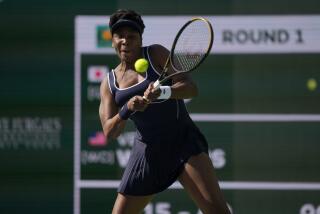Rubin Gets Over the Hump on the Comeback Trail
- Share via
Chanda Rubin was good enough three years ago to defeat the world’s No. 1-ranked player, Martina Hingis, at Indian Wells, but that probably seemed like a lifetime ago as she lay in a hospital bed in Vail, Colo., in January.
Rubin, once considered the heir apparent to Zina Garrison as the next great African American women’s tennis player but later eclipsed by the Williams sisters, had just had surgery on her left knee for the second time in 13 months.
Victories over top-ranked players, such as the 6-2, 4-6, 7-5 defeat she hung on Wimbledon and French Open champion Serena Williams on Friday in the quarterfinals of the JPMorgan Chase Open in Manhattan Beach, seemed a distant memory.
Such thoughts didn’t cross her mind, but neither did retirement.
“I did think, ‘This can’t be happening again. I’ve done all this work and here I am back at the same place again,’ ” said Rubin, a pro for 11 years but still only 26. “It was very disappointing and sort of a low point, but I never felt I was just going to pack it in and not do this anymore. I still felt that I had some good years left and I hadn’t maximized my abilities.”
Eventually, her focus and determination returned. Through 10 weeks of rehabilitation, almost identical to the physical and mental torture she had put herself through only a year earlier, Rubin started to believe again.
One week after losing to Nathalie Vierin of Italy in the first round of qualifying at the Italian Open in May, she reached the final in Madrid before losing to Monica Seles. At the French Open, she lost to Venus Williams in the round of 16.
In June, she won a Wimbledon warm-up event at Eastbourne, England, before losing to Serena Williams in the round of 16 at Wimbledon.
Her comeback was progressing nicely, if not spectacularly, her ranking rising to No. 21. But few would have guessed she’d hand Serena Williams her first loss since May, ending a 21-match winning streak that had vaulted Williams to No. 1.
“Nobody could have figured on this,” said Rubin’s coach, Benny Sims. “I’m so proud. I don’t know anybody who could have worked harder to rehabilitate.”
After losing to Vierin in Rome, Rubin was put through a sort of one-week boot camp by Sims, enduring two-a-day practices against male opponents, plus conditioning drills, at a club in Germany.
Her knee, which never fully healed as she struggled last year after arthroscopic surgery in January 2001, responded well, and her confidence soared.
“I never really put a limit on it,” she said of her comeback. “I knew at a certain point, if I was playing well, that anything was possible. I just have to give myself a chance out there.”
She did more than that against the frustrated and faltering Williams.
Or, as Williams said afterward, “She had to play great tennis to beat me. Anyone who beats me has to play great, so obviously I think she played really, really well today. She did great.
“She has a tough game. She attacks a lot of balls, she’ll try to keep you running and she’s really cut back on her errors.”
And, for the first time in nearly two years, she’s all in one piece.
“Physically, I feel good,” Rubin said. “I feel like I can just build on my fitness ... but the knee feels good and I’m able to do everything I need to do on it.”
She called this her biggest victory, eclipsing the upset of Hingis.
“This is three years later and I’ve been through a little more adversity,” she said, “so it’s definitely more satisfying. I feel like I’m playing better than I was then, and I’ve felt that for a while, so to finally actually prove it is very satisfying.”
More to Read
Go beyond the scoreboard
Get the latest on L.A.'s teams in the daily Sports Report newsletter.
You may occasionally receive promotional content from the Los Angeles Times.










